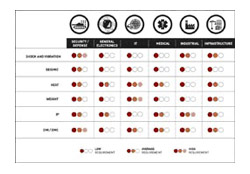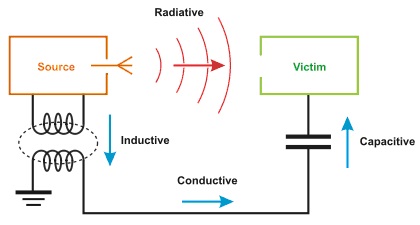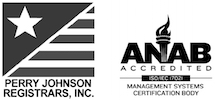Rackmount Computers and Monitors
The innovation of electro-mechanical technologies, paired with compliance and compatibility requirements, results in the development and expansion of high-performance electronics beyond customary 19-inch Data-Communications and Telecommunications applications.
Rackmount computers are designed to provide effective and strong protection of sensitive electronics in non-communications environments such as extreme heat, high amount of dust or contaminants, clean room/laboratories, Radio Frequency/Electromagnetic interference, and high shock and vibration.
This article will demonstrate important ways of mechanical structure and protection standards design for a dependable 19-inch rackmount computer and monitor.
Design Standards
Standards committees, government agencies, and regulators classify and develop the design standards. Standards are determined from technical agreements relating to the design specifications and requirements that need to be fulfilled by a product or service. The standards are broadly used by engineers, manufacturers, trade organizations, testing laboratories and other vested parties so they are widely recognized at the domestic and international levels. Several key design standards are of the following:
IEC and NEMA
International Electrotechnical Commission (IEC) establishes International standards for all electrical, electronic, and related technologies. Although it is not required, they are frequently used as references in national laws or regulations around the world. Experts from all around the world join forces and develop IEC International Standards.
IEC 60297 standard offers critical information for designing 19” rackmount computers and monitors.
The National Electrical Manufacturers Association (NEMA) is an association of electrical equipment and medical imaging manufacturers. It was founded in 1926 and has over 400 companies, providing a forum for the development of technical design and safety standards that are in the best wellbeing of the industry and users.
Each of the standards organization includes member companies from various industries that manufacture products used in the generation, transmission, distribution, and utilization of electricity. Some of the examples include industrial, test and measurement, medical imaging, energy, transportation, and communications.
Network Equipment-Building System (NEBS)
Even though NEBS is not a regulatory requirement, it is used as a best-practices standard that became commonly referenced in the telecom industry. Telcordia controls specifications and provides a series of General Requirements for communications electronic and mechanical solutions; key rackmount computer requirements include NEBS GR-63-CORE (physical protection such as thermal load calculation and seismic Zone 4) and GR-1089-CORE (electromagnetic compatibility and electrical safety.
UL Standard
UL (Underwriters Laboratory) focuses on ensuring electrical safety standards and is a global independent safety consulting and certification company.
RoHS Compliance
Restriction of Hazardous Substances came from the European Union and restricts the use of six harmful materials found in electrical and electronic products.
MIL-S-901D
A special military test requirement intended for shipboard applications. Based on the type of the equipment- critical or non-critical to the safety and combat-readiness of the ship- qualification testing is performed on a specified machine placed on a barge floating in a pond where explosive charges are detonated at a range of distances and depths in the pond to convey shock upon the equipment.
Cabinet Dimensions
19-inch rackmount computers and monitors are considered a standardized frame or enclosure for mounting numerous types of electronics equipment. Including the edges or mounting ears, each piece of equipment is usually 19 inches wide, allowing it to be mounted on the rack frame. Cabinet height is described in “Units” (U) and each unit equals an industry standard of 1.75 inches. Rack-mountable equipment is usually designed to occupy a specified number of U. For instance, a piece of test equipment could be 4U high, most rack-mountable computers are between 1U and 5U and some high-availability computing solutions may need as much as 13U.
Thermal Management and Cooling
Thermal management is a vital design consideration for any electrical or electronics enclosure. A common reason for operation failures could be thermal overload. As the power density of today’s electronics increases and more heat is generated, the risk increases for equipment mounted into rackmount computers. Heat dissipation is calculated in measurements of ΔT (Delta T), measured in degrees Fahrenheit, which refers to the discrepancy between the intake air and exhaust air, or the amount of heat that is carried away by the stream of air exiting the heat load. When more heat is removed, there will be a greater temperature difference. An ideal formula for calculating heat dissipation requirements within a cabinet is Watts = .316 x CFM x ΔT (CFM = cubic feet per minute).
Systems nowadays have higher operating temperatures and require more energy for power and cooling due to the increase in density of processors and electronic components, as well as added processing power. The risk of thermal failure is increased because of the smaller system footprints as it put a strain on cooling systems. Studies have shown that for every 10°C/18°F rise above normal room temperature (22.2° to 23.9°C/72° to 75°F) the life expectancy of enclosed electronics components is reduced by 50 percent.
Rackmount computers and monitors that are designed for universal applications must be compatible with broad thermal management. There are various thermal management and cooling options that may be deployed in rackmount computers, from high perforation, referred to as a passive option, to fan trays, heat exchangers, and air conditioners referred to as active options.
Shock and Vibration Protection

Seismic and shock/vibration (S/V) tests are the two main dynamic requirements. It is important to note that S/V and seismic tests are very different and have very well-defined processes on loading rackmount computers with weight. To ensure that the final solution is the same S/V or seismic protection as desired, it is needed to retest with the exact equipment. But if the equipment is below the threshold of the official test, the test is not needed. Although the tests might look very simple, they deal with very complex waveforms, material structure, and material fatigue.
Shock and Vibration
This is a go-to test for equipment that will be used in mobile applications and simulates a typical environment in a train, car, and vehicle or next to vibration-generating equipment such as a punch press or other piece of industrial equipment. Since a lot of applications involve transportation, the weight of the solution may be something that engineers need to minimize, and S/V-optimized designs can offer long-term benefits to users.
Seismic
Seismic activity is a phenomenon that is very complicated but well-studied. Multiple labs that are capable of doing the tests experiment the equipment and processes that are well-defined and well-known. The test involves placing a fully loaded, standard cabinet onto a platform that can move in any direction and simulate Earth’s movements during a seismic event. Certain deformation and movement of the cabinet can simply lead the test to fail.
Electromagnetic Compatibility (EMC)
Electromagnetic interference (EMI) has been a rising concern with equipment manufacturers. As equipment becomes faster and reproduces into all types of manufacturing and production environments, the issue of EMI has become more common. Due to an increase in automation equipment and electronics emissions, environments that were once considered EMI-free are becoming more and more susceptible. Unlike other requirements, it is nearly impossible to determine the competence of gaskets to achieve desired protection through visual inspection alone.
To ensure that a rackmount computer design meets those requirements, proper tests and results are needed. Although it may sound easy to incorporate gaskets and provide a Faraday Effect, the reality is a lot more intricate due to competing requirements such as rackmount computer cooling and perforations for airflow. The latter stresses an understanding of the entire system, not just individual components, and necessitates a number of accessories that may seem redundant but solve very specific problems.

Environmental and Safety
The National Electrical Manufacturers Association publishes performance standards of various classes of electrical enclosures. The NEMA standards cover corrosion resistance, the ability to protect from rain and submersion, and other key requirements.
IP and NEMA handle dust and water protection. Equipment that has better protection against dust/objects and water will result in higher ratings. IP ratings have two numbers- one showing dust/object protection and the other showing water protection. NEMA, on the other hand, has pre-established ratings for both.
A common misperception is that IP/NEMA protection is visual and does not require testing. Reputable manufactures would never design a product to meet particular specifications and skip testing. A test is to validate design expertise and serves multiple purposes and the value of test reports cannot be over-emphasized. No rating is good or bad, as each rating meets specific requirements. There is no reason to over-engineer and overprice a solution that will never be exposed to water and it is critical to have a solution that meets the minimum requirements for the projected application.
For some industries, the requirements might be higher than others, like in transportation, military, and food and beverage. These industries might have high requirements for IP/NEMA rating because of the nature of the intended applications as compared to other industries. Partnering with a supplier that has a solid understanding of the various requirements, has built various types of IP cabinets and can show test reports are beneficial.
Conclusion
When designing 19-inch electronics enclosures that is outside of traditional data and telecommunications application, it is critical and important to partner with a provider who has experienced a history of working within stringent global design standards and is able to work in providing the right cabinet solution that meets the performance requirement of the entire system.
About Acnodes Corporation
Acnodes manufacturers, designs, and markets industrial computers and displays for diverse industries ranging from automation to military. We have an array of technological innovations in the area of rackmount servers, embedded computers, Panel PC’s and rugged monitors that create simpler and more valuable products to customers. We work closely with our clients to customize computer products to meet their required projects and challenges. Acnodes strives to explore new technologies to better improve life and work.




